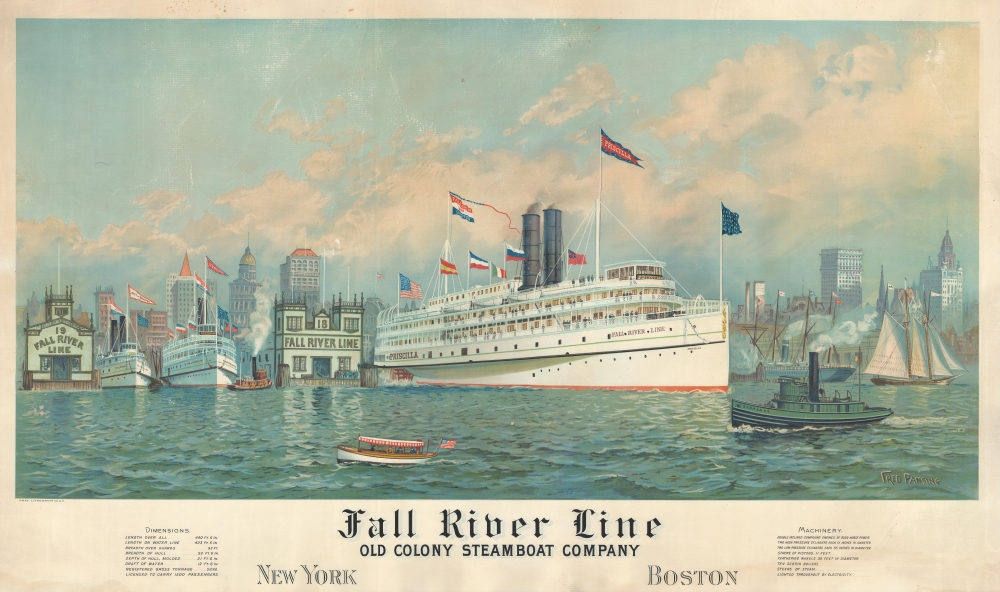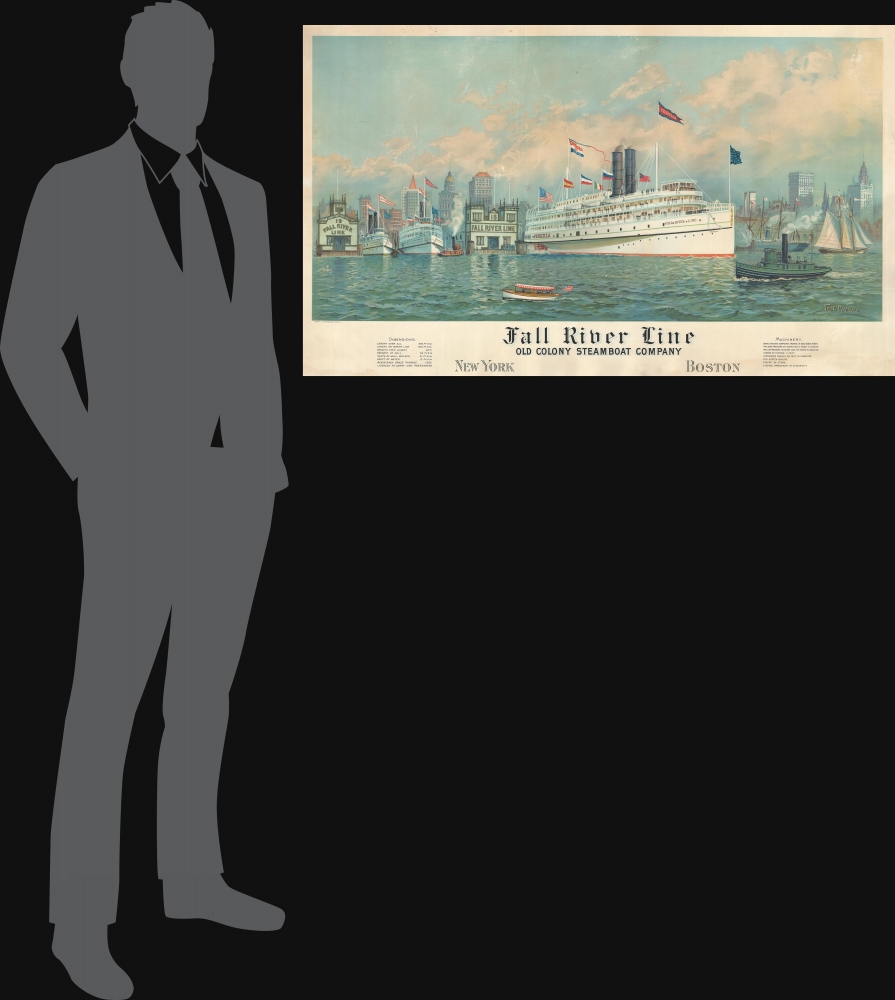This item has been sold, but you can get on the Waitlist to be notified if another example becomes available, or purchase a digital scan.
1896 Pansing View of East River Steamboats, New York City
FallRiverLineNewYork-pansing-1896
Title
1896 (undated) 23.25 x 39.25 in (59.055 x 99.695 cm)
Description
A Closer Look
Oriented towards the southeast, the view takes in the Hudson River and the waterfront of Manhattan from roughly the location of today's Stuyvesant High School. In the decades since the view was drawn, especially during redevelopment projects in the 1960s and 1970s, landfill expanded the shoreline significantly to create the neighborhood of Battery Park City.Taking center stage is the Priscilla, a magnificent steam-powered passenger paddleboat belonging to the Old Colony Steamboat Company, which ran along the Fall River Line. Smaller boats owned by the same company with services bound for Plymouth and Brockton, Massachusetts sit at left. The buildings for Pier 18 and Pier 19, dedicated to the Old Colony lines, stand prominently in the foreground (the company used different piers during its existence, but remained at Piers 18 and 19 during the bulk of its heyday at the turn of the 20th century). Other craft, including two tugboats, a sailboat, a small steamer, and a pleasure craft, surround the Priscilla.
Early Skyscrapers of Manhattan
This view is remarkable for capturing Lower Manhattan in the early phase of a skyscraper building boom. At left are a cluster of skyscrapers known as 'newspaper row' where the New York Times, New York Tribune, and New York World all had built tall and gleaming structures to reflect their influence and aspirations. The gold-domed structure is the New York World Building (completed 1890), the tallest building in New York, if not the world, when completed; it was demolished in 1955. The Tribune Building (completed 1875), the earliest constructed and shortest of the three, is mostly obscured by the Pier 18 Building from this angle. The New York Times Building is similarly blocked by the tall building topped by a red hexagonal roof, the American Tract Society Building (150 Nassau St., completed 1895).At right, the steeple of Trinity Church, the city's tallest building between 1846 and 1890 (surpassed by the New York World Building), is partially obscured by a sailboat. Directly to the left of it (across the street) is the American Surety Building (completed 1896). To the right of Trinity Church is the Manhattan Life Insurance Building (completed 1894), with its distinctive reddish-beige domed roof. The tallest building in Manhattan when completed (at 348 feet), it was demolished in the early 1960s.
Interesting in its own right, the identification of skyscrapers is also useful for dating the view. Several skyscrapers are not visible, including the Empire Building (completed 1898), the St. Paul Building (1898), and the Park Row Building (1899). These omissions indicate that Pansing's work would have to date from between 1896 and 1898.
Fall River Line
Though little remembered today, the Fall River Line was renowned at the turn of the 20th century for being a fast, comfortable, and luxurious means of traveling between Boston and New York. A service along this route was established by Colonel Richard Borden in 1847 and quickly became one of the more successful lines in the burgeoning steamboat industry providing routes between New York City and various points in New England.In the 1860s, ownership and operation of the line changed frequently, but a period of stability began when the line was bought by the Old Colony Railroad in 1872 and renamed the Old Colony Steamboat Company. As the Old Colony system already included a rail line between Fall River and Boston, this combined rail and steamship line was a major advantage over competing methods of travel between the two cities.
Ownership by the Old Colony also brought investment in large new ships, which could make the trip between New York and Fall River, typically overnight, in 8 and a half hours. Though the Old Colony ran other routes, the Fall River line was by far the most popular and came to be a metonym for the entire company.
The Fall River Line was extremely popular with passengers, especially well-heeled New Yorkers and Bostonians, and was seen as far superior to traveling the entire route by rail. Service was prompt and accommodations were sumptuous; palatial even. Though there were ticket classes like any passenger steamship, an unusually large proportion of accommodations were devoted to first-class passengers. Similar to first-class Pullman railroad cars of the same era, many of the pursers, porters, chefs, and waitstaff on the ships were Black. As with Pullman Porters, this work entailed suffering discrimination and condescension but could provide a decent income (primarily from tips instead of wages).
Despite its good reputation, the Fall River Line was damaged by improved rail service between New York City and New England and the rise of automobiles. Moreover, by the 1920s its ships had become outdated. Though it survived for some time afterwards, the Great Depression was especially destructive for the Fall River Line, which relied on affluent customers, and the service ended in 1937.
The Priscilla
Until its final years, the ships of the Fall River Line were typically paddle steamers employing a large steam-driven paddle on the starboard side of the ship. For the time, they were state-of-the-art vessels, and were among the largest paddleboats ever constructed. The decks and interiors were designed with charm and elegance in mind. The Priscilla, seen here, was among the grandest of all the company's steamboats. At the time it was launched in 1894, and for some years after, the Priscilla was the largest side-wheeler afloat, capable of accommodating 1,500 passengers.Chromolithography
Chromolithography, sometimes called oleography, is a color lithographic technique developed in the mid-19th century. The process involved using multiple lithographic stones, one for each color, to yield a rich composite effect. Oftentimes, the process would start with a black basecoat upon which subsequent colors were layered. Some chromolithographs used 30 or more separate lithographic stones to achieve the desired product. Chromolithograph color could also be effectively blended for even more dramatic results. The process became extremely popular in the late 19th and early 20th centuries, when it emerged as the dominant method of color printing. The vivid color chromolithography produced made it exceptionally effective for advertising and propaganda imagery.Publication History and Census
This view was drawn by Fred Pansing, who produced several other drawings for the Old Colony Steamboat Company, and lithographed by the Gray Lithograph Co. It is undated, but as explained above can be tentatively dated to 1896 from the skyscrapers visible. The only known example of this work in institutional collections is held by the Huntington Library as part of the John Haskell Kemble Maritime, Travel, and Transportation Collection.CartographerS
Fred Pansing (1844 - 1912) was an accomplished painter of ships and other maritime themes who was especially known for his depictions of passenger steamships. Born in Bremen, Germany, a famous maritime city, he migrated to New Jersey in his childhood and became a sailor in his teenage years. In 1872, he began his artistic career, though nothing is known of his training or preparation. His years at sea served him well, as Pansing became known for his highly realistic depictions of sailboats and steamboats and was especially renowned for his close attention to minute details. His works include oil on canvas and lithography, as well as, late in his career, photography. His lithographs were commonly though not exclusively printed by Major and Knapp in New York. More by this mapmaker...
Olin D. Gray (1854 - September 2, 1938) was an American lithographer. Born in Remsen, New York, Gray was living in St. Louis, Missouri, by 1860. Gray became the manager of August Gast and Company in St. Louis in 1885. By 1887, when the St. Louis firm was reorganized, Gray was working in the New York office with Louis Wall, who had been a partner in the firm in St. Louis. The New York branch produced chromolithographs and used lithographic stones up to 36 x 52 inches. Gray opened his own lithographing firm, the Gray Lithographing Company, in 1896 when Wall moved to Brooklyn and opened his own company. Gray also maintained the Gast Lithographing and Engraving Company until 1910. Gray sold the Gray Lithographing Company in 1910 to the Sackett and Wilhelms Company. The Gray Lithographing Company existed until 1930. Gray married Lydia Blossom Gwin on September 6, 1883, with whom he had two children. Learn More...




